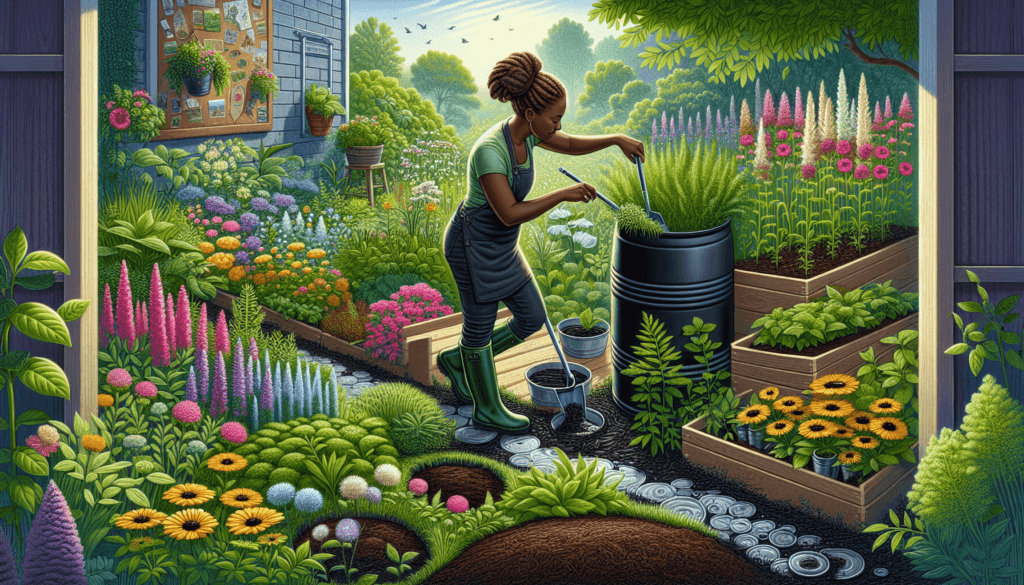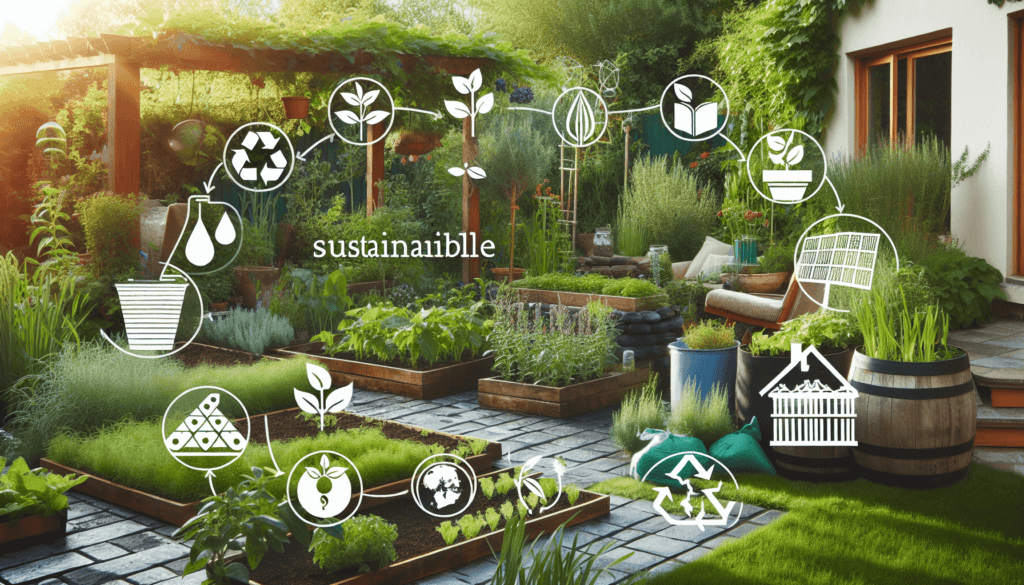In this concise guide, discover the key principles and practices of sustainable landscaping. Whether you have a sprawling garden or a small backyard, this article will provide you with essential tips and techniques to create an eco-friendly and beautiful outdoor space. From selecting native plants to conserving water, you’ll learn how to reduce your environmental impact while enjoying the benefits of a vibrant and sustainable landscape. With this guide, you’ll be able to transform your outdoor space into a haven for both you and the planet.

Water Conservation
Collecting Rainwater
One of the most effective ways to conserve water in your landscape is by collecting rainwater. By installing rain barrels or cisterns, you can capture rainwater from your roof and use it to water your plants and garden. This not only helps to reduce your reliance on municipal water supplies but also reduces stormwater runoff, which can carry pollutants into rivers and lakes.
Installing Drip Irrigation Systems
To further conserve water, consider installing a drip irrigation system in your landscape. Drip irrigation delivers water directly to the roots of plants, minimizing evaporation and ensuring that each plant receives the right amount of water. This method is much more efficient than traditional sprinkler systems and can reduce water usage by up to 50 percent.
Choosing Native Plants
Another important aspect of water conservation is selecting native plants for your landscape. Native plants have adapted to the local climate and require less water once established. They are also more resistant to pests and diseases, reducing the need for chemical interventions. By incorporating native plants into your landscape design, you can create a beautiful and sustainable environment that conserves water.
Mulching
Mulching is a simple yet effective technique for conserving water in your landscape. Applying a layer of organic mulch, such as wood chips or shredded leaves, around your plants helps to retain moisture in the soil and suppress weed growth. This reduces the need for frequent watering and minimizes water loss through evaporation. Additionally, mulch adds organic matter to the soil as it breaks down, improving its overall health and fertility.
Soil Health
Composting
Composting is a key practice that promotes soil health and fertility. By composting kitchen scraps, yard waste, and other organic materials, you can create a nutrient-rich soil amendment that adds essential nutrients and improves soil structure. Compost also helps retain moisture in the soil, reducing water needs. Incorporating compost into your landscape beds and gardens each year can improve plant growth and minimize the need for synthetic fertilizers.
Soil Testing
To ensure optimal soil health, it’s important to regularly test your soil. A soil test can provide valuable information about the pH level, nutrient content, and organic matter content of your soil. Based on the test results, you can adjust your fertilization and amendment practices to meet the specific needs of your plants. This helps to avoid over-fertilization, which can lead to nutrient runoff and water pollution.
Amending Soil
In addition to compost, there are several other soil amendments that can improve soil health. Adding organic matter, such as well-rotted manure or leaf mold, can increase soil fertility and improve its ability to retain water. Incorporating vermicompost or biochar into the soil can enhance its structure, drainage, and nutrient-holding capacity. By carefully selecting and applying soil amendments, you can create a healthy and productive growing environment in your landscape.
Using Organic Fertilizers
When fertilizing your landscape, opt for organic fertilizers instead of synthetic ones. Organic fertilizers are derived from natural sources like compost, manure, and bone meal. They release nutrients slowly over time, providing a steady supply of nutrients to your plants without the risk of leaching into groundwater. By choosing organic fertilizers, you can support a healthier soil ecosystem and reduce the environmental impact of your landscaping practices.
Reducing Chemical Usage
Integrated Pest Management
Integrated Pest Management (IPM) is a proactive approach to pest control that aims to minimize the use of chemical pesticides. It involves identifying pests, monitoring their populations, and implementing a combination of cultural, biological, and mechanical controls to manage them effectively. By encouraging beneficial insects, practicing regular sanitation, and using physical barriers, you can reduce pest infestations without resorting to harmful chemicals.
Alternative Weed Control
Instead of relying on chemical herbicides, consider using alternative methods to control weeds in your landscape. Hand-pulling weeds, using mulch to suppress weed growth, and applying vinegar-based or organic herbicides can effectively manage weed populations. Additionally, planting ground covers or using landscape fabric in high-weed areas can prevent weeds from taking root and competing with your desired plants.
Natural Plant Disease Prevention
Preventing plant diseases can significantly reduce the need for chemical intervention. Start by selecting disease-resistant plant varieties and providing optimal growing conditions, including adequate sunlight, proper watering, and good air circulation. Regularly inspect your plants for signs of disease and promptly remove and dispose of infected plant material. Proper sanitation practices, such as cleaning tools and equipment, can also prevent the spread of disease-causing pathogens.
Wildlife Habitat
Creating Wildlife-Friendly Gardens
By designing your landscape to provide food, water, cover, and nesting sites for wildlife, you can create a thriving habitat that supports a diverse range of species. Incorporate native plants that provide nectar, berries, and seeds, as well as plants with different heights and structures to accommodate various wildlife needs. Add features like bird baths, ponds, and rock piles to attract and support wildlife.
Providing Food and Water Sources
To attract wildlife to your landscape, provide supplemental food and water sources. Bird feeders, butterfly feeders, and nectar-rich plants can attract hummingbirds, butterflies, and other beneficial insects. Install shallow dishes or birdbaths with fresh water for drinking and bathing. By ensuring a reliable food and water supply, you can encourage wildlife to make your landscape their home.
Building Nesting Boxes
Birdhouses, bat boxes, and insect hotels are important additions to your landscape if you want to support nesting and roosting wildlife. Different species have specific requirements for nesting, and providing suitable habitat can help increase their populations. Research the nesting requirements of local bird and bat species, and build or purchase appropriate nesting boxes to attract and support these creatures.
Minimizing Use of Pesticides
To maintain a wildlife-friendly landscape, it’s crucial to minimize the use of pesticides, especially those that are toxic to beneficial insects and pollinators. Avoid using broad-spectrum insecticides and opt for targeted, organic pest control methods instead. Natural predators, like ladybugs and praying mantises, can help keep pest populations in check, reducing the need for chemical interventions.

Energy Efficiency
Using LED Lighting
To reduce energy consumption in your landscape, consider using LED lighting. LED (Light Emitting Diode) bulbs are highly energy-efficient, consuming significantly less electricity than traditional incandescent or halogen bulbs. LED lights also have a longer lifespan, reducing the frequency of bulb replacement. By illuminating your landscape with LED lights, you can enjoy a well-lit outdoor space while minimizing your energy usage.
Choosing Low-Maintenance Plants
Opting for low-maintenance plants can help reduce the energy required to maintain your landscape. Choose plant species that are well-suited to your climate and soil conditions, as they will require less water, fertilizer, and pruning. Look for drought-tolerant plants that can survive on natural rainfall without the need for extensive irrigation. By selecting low-maintenance plants, you can create an attractive landscape with minimal energy input.
Installing Solar-Powered Features
Incorporating solar-powered features into your landscape can significantly reduce your reliance on conventional energy sources. Solar-powered lights, water features, and even irrigation systems can be powered by the sun’s energy, eliminating the need for electricity. By harnessing the power of the sun, you can enjoy a more sustainable and energy-efficient landscape.
Reducing Lawn Areas
Maintaining a large lawn requires significant amounts of water and energy to mow, fertilize, and maintain. Consider reducing lawn areas in your landscape and replacing them with low-maintenance alternatives. Planting native ground covers, creating wildflower meadows, or installing permeable hardscapes can reduce water and energy consumption while adding visual interest to your landscape.
Stormwater Management
Building Rain Gardens
Rain gardens are a great way to manage stormwater runoff in your landscape. By planting native, water-loving plants in a depressed area of your yard, you can create a natural basin that collects and filters rainwater. This helps to prevent erosion, reduce the amount of water entering storm drains, and replenish groundwater supplies. Rain gardens also provide habitat for pollinators and other beneficial wildlife.
Installing Permeable Pavement
Traditional paved surfaces, such as driveways and walkways, contribute to stormwater runoff by preventing rainwater from infiltrating into the soil. Installing permeable pavement, such as permeable concrete or porous pavers, allows rainwater to penetrate through the surface and recharge the groundwater. This can help reduce runoff, alleviate flooding, and improve water quality by reducing the pollutants carried by stormwater.
Diverting Runoff with Swales
Swales are shallow channels or depressions designed to redirect and slow down stormwater runoff. By incorporating swales into your landscape, you can capture and infiltrate rainwater, preventing it from flowing into storm drains. Swales can be vegetated with grass or planted with native species to enhance water absorption and provide habitat for wildlife. They are especially effective in sloped areas where runoff is more significant.
Using Green Roofs
Green roofs, also known as living roofs, are vegetated surfaces installed on the tops of buildings. They provide numerous environmental benefits, including stormwater management. Green roofs absorb rainwater, reducing the amount of runoff that enters storm drains. They also provide insulation, improve air quality, and increase urban biodiversity. By implementing green roofs, you can create sustainable and visually appealing landscapes.

Pollution Prevention
Proper Disposal of Yard Waste
When cleaning up your landscape, it’s essential to properly dispose of yard waste to prevent pollution. Instead of bagging leaves and grass clippings for curbside collection, consider composting these materials or using them as mulch. Yard waste can also be taken to local composting facilities or used in community composting programs. Proper disposal of yard waste prevents it from ending up in landfills, where it can contribute to greenhouse gas emissions.
Using Eco-Friendly Pesticides
If the use of pesticides is necessary in your landscape, opt for eco-friendly, low-toxicity options. Look for products that are certified organic or approved for use in organic gardening. These pesticides use natural or biological ingredients to target pests while minimizing harm to beneficial insects, wildlife, and water systems. Integrated Pest Management techniques can also help reduce the need for pesticide use.
Reducing Runoff from Paved Surfaces
Paved surfaces, such as driveways and patios, can contribute to pollution by allowing rainwater to pick up contaminants and carry them into storm drains. To reduce runoff and pollution, consider installing permeable pavers or using porous materials that allow water to infiltrate into the ground. Properly designed and maintained drainage systems can also help capture and treat runoff, reducing its negative impact on the environment.
Biodiversity Enhancement
Creating Plant Diversity
Plant diversity plays a crucial role in supporting a healthy ecosystem. By incorporating a variety of plant species in your landscape, you can provide food and habitat for a wide range of wildlife, including birds, butterflies, and beneficial insects. Select plants with different flowering periods to provide a continuous food source throughout the year. Including a mix of trees, shrubs, flowers, and grasses will create a harmonious and biodiverse landscape.
Preserving Existing Trees
If your landscape already has mature trees, it’s essential to preserve them. Trees provide numerous ecological benefits, such as shade, carbon sequestration, and habitat for wildlife. Avoid unnecessary tree removal and take measures to protect existing trees during construction or renovation projects. Regularly inspect your trees for signs of disease or damage and consult an arborist for proper care and maintenance.
Incorporating Butterfly Gardens
Butterfly gardens are specifically designed to attract and support these beautiful insects throughout their life cycle. By planting nectar-rich flowers, host plants for caterpillars, and providing water sources, you can create an inviting habitat for butterflies. Incorporate a mix of native plants that bloom at different times to ensure a continuous food supply. Adding features like flat rocks or sand patches can also serve as basking spots for butterflies.
Building Birdhouses
Birdhouses provide essential nesting sites for cavity-nesting birds, such as bluebirds and chickadees. By installing birdhouses in your landscape, you can help support bird populations and encourage them to nest in your yard. Research the specific requirements of different bird species and construct or purchase birdhouses that meet their needs. Properly maintained birdhouses can provide a safe and comfortable environment for breeding and raising young.

Maintenance Best Practices
Proper Watering
Proper watering is vital for maintaining a healthy landscape. Water deeply and infrequently to encourage deep root growth and water absorption. Irrigate early in the morning or late in the afternoon to minimize evaporation. Use a rain gauge or moisture sensor to determine when to water, and adjust watering frequency based on weather conditions. Avoid overwatering, as it can lead to shallow root growth and increased susceptibility to pests and diseases.
Regular Pruning
Regular pruning promotes healthy plant growth and improves the overall appearance of your landscape. Remove dead, damaged, or diseased branches to prevent the spread of pests and diseases. Prune to maintain the natural shape and size of your plants, ensuring proper air circulation and sunlight penetration. Always use clean and sharp tools to make clean cuts and minimize plant stress. Proper pruning techniques can help enhance the health and beauty of your landscape.
Weed and Pest Control
Effective weed and pest control is essential for maintaining a thriving landscape. Regularly inspect your plants for signs of pests or diseases and take appropriate action if necessary. Hand-pull or use targeted treatments for weeds to prevent them from spreading. Implement integrated pest management techniques to naturally control pests and reduce the need for chemical interventions. Regular monitoring and proactive measures can help prevent small issues from becoming major problems.
Mulch Renewal
Regularly renewing your mulch is important for maintaining its effectiveness. Mulch breaks down over time and loses its ability to suppress weeds and retain moisture. Add a fresh layer of mulch each year to rejuvenate its benefits. Before applying new mulch, remove any weeds or debris from the surface. Maintain an adequate thickness of mulch, typically 2-3 inches, to ensure proper weed suppression and moisture retention.
Long-Term Planning
Designing for Future Growth
When planning your landscape, consider the long-term growth of your plants. Research the mature size and growth habits of each plant species to ensure they have adequate space to grow. Avoid planting trees or shrubs too close to buildings or structures, as their roots or branches may cause damage over time. By designing with future growth in mind, you can create a landscape that remains visually appealing and functional for years to come.
Choosing Perennials for Stability
Perennials play a vital role in creating a sustainable landscape. Unlike annual plants that need to be replanted each year, perennials come back year after year, reducing the need for constant replanting. Choose native perennial plants that are well-suited to your climate and soil conditions. These plants are adapted to the local environment and often require less water, fertilizer, and maintenance. By incorporating perennials into your landscape, you can establish a stable and low-maintenance garden.
Implementing Seasonal Planting Plans
Implementing a seasonal planting plan can help maintain a dynamic and visually appealing landscape throughout the year. Select plants that bloom or exhibit distinctive foliage during different seasons to provide interest and diversity. Plan for a mix of early spring, summer, fall, and winter-blooming plants to ensure year-round beauty. Incorporating seasonal plantings can transform your landscape into a vibrant and ever-changing outdoor space.
In conclusion, sustainable landscaping practices are vital for preserving the natural environment while creating beautiful and functional landscapes. By adopting water conservation techniques, promoting soil health, reducing chemical usage, enhancing wildlife habitat, prioritizing energy efficiency, managing stormwater, preventing pollution, encouraging biodiversity, following maintenance best practices, and planning for the long term, you can create a sustainable and environmentally-friendly landscape that benefits both you and the natural world. With these practices in place, your landscape can thrive while minimizing its impact on the planet.



